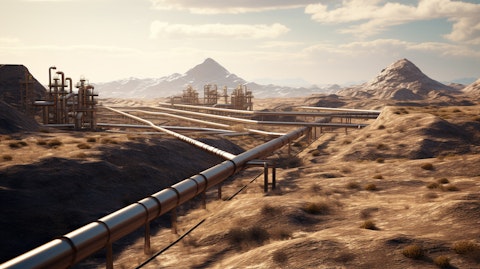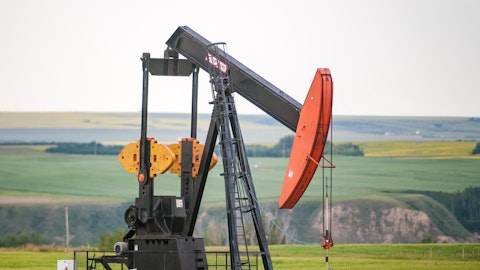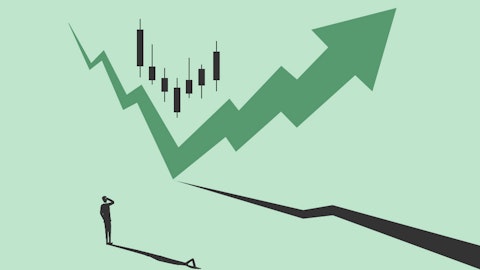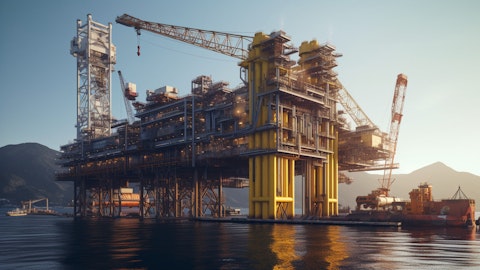ConocoPhillips (NYSE:COP) Q3 2023 Earnings Call Transcript November 2, 2023
ConocoPhillips beats earnings expectations. Reported EPS is $2.33, expectations were $2.04.
Operator: Welcome to the Third Quarter 2023 ConocoPhillips Earnings Conference Call. My name is Liz, and I will be your operator for today’s call. [Operator Instructions]. I will now turn the call over to Phil Gresh, Vice President, Investor Relations. Sir, you may begin.
Philip Gresh: Yes. Thank you, and welcome to everyone, to our third quarter 2023 earnings conference call. On the call today are several members of the ConocoPhillips leadership team, including Ryan Lance, Chairman and CEO; and Tim Leach, Adviser to the CEO; Bill Bullock, Executive Vice President and Chief Financial Officer; Dominic Macklon, Executive Vice President of Strategy, Sustainability and Technology; Nick Olds, Executive Vice President of Lower 48; Andy O’Brien, Senior Vice President of Global Operations; Kirk Johnson, Senior Vice President, Lower 48, Assets and Operations; and Will Giraud, Senior Vice President, Corporate Planning and Development. Brian and Bill will kick it off with opening remarks, after which the team will be available for your questions.
A few quick reminders. First, along with today’s release, we published supplemental financial materials and a slide presentation, which you can find on the Investor Relations website. Second, during this call, we will make forward-looking statements based on current expectations. Actual results may differ due to factors noted in today’s release, and in our periodic SEC filings. We will make reference to some non-GAAP financial measures. Reconciliations to the nearest corresponding GAAP measure can be found in today’s release and on our website. And before I turn it over, I just want to flag for today, we’ll do one question per caller. So with that, let me turn it over to Ryan.
Ryan Lance: Thank you, Phil, and thank you to everyone for joining our third quarter 2023 earnings conference call. It was another solid quarter for ConocoPhillips, as the team continued to deliver strong underlying performance across the portfolio, and we have achieved several additional project milestones in our international portfolio in early October. Now before I get into the details, I wanted to address the topical news in the industry, which has been the M&A headlines in recent weeks. This is not a surprise to us. We have long said that we expect to see further industry consolidation. ConocoPhillips remains steadfast in our returns-focused value proposition and cost of supply principles, which creates a high bar for M&A.
And as a reminder, we’ve been actively high grading our own portfolio over the past several years. And as a recent example, we are pleased to have closed on the acquisition of the remaining 50% of Surmont, in early October. An opportunity came along to acquire this asset at a very attractive price that fit our financial framework, an asset we can make better through our full ownership and an acquisition that makes our 10-year plan even better. Surmont is a long life, low declining and low capital intensity asset that we know well. We achieved first steam from Pad 267 in the third quarter, and production is expected to start up in the first quarter of 2024. This is our first new pad addition since 2016, and as we said at our recent analyst meeting, we can leverage existing infrastructure to add additional pads with very limited capital requirements in the years ahead.
Now moving to global LNG. We’ve also continued to progress our strategy, securing 1.5 mtpa regas capacity at the Gate LNG terminal in the Netherlands. This will take our total European regas capacity to 4.3 mtpa. We have now effectively secured destinations for nearly half of our Port Arthur LNG offtake commitment in the first 6 months. since we sanctioned the project. Now elsewhere in the international portfolio, we started up our second central processing facility, CPF2 in the Montney. And in Norway, we just announced that we have started up 3 project developments ahead of schedule in October. This includes the company-operated Tommeliten Alpha A, subsea tieback project at Ekofisk, which is nearly 6 months earlier than originally planned as well as 2 nonoperated projects.

Finally, in China, our partner started at Bohai Phase 4b ahead of schedule, in October. So as you can see, our diversified international portfolio continues to be a strong differentiator for our company. Shifting to results. We have record global and Lower 48 production in the third quarter, and we raised our full year production guidance to account for the closing of the Surmont acquisition, all this while achieving continued capital efficiency improvements as our full year capital guidance remains unchanged. We also continued to deliver on our returns to our shareholders. We increased our quarterly ordinary dividend by 14%, consistent with our long-term objective to deliver top quartile increases relative to the S&P 500. We have distributed $8.5 billion in dividends and buybacks year-to-date, and we remain on track for our $11 billion full year target.
And we did this while funding the shorter and longer-term organic capital growth opportunities that we see across the entire portfolio. The team continues to execute well. Our deep durable and diversified asset base continues to get better and better, and we are well positioned to generate competitive returns, and cash flow for decades to come. Now let me turn the call over to Bill to cover our third quarter performance in more detail.
William Bullock: Thanks, Ryan. In the third quarter, we generated $2.16 per share in adjusted earnings. We produced 1,806,000 barrels of oil equivalent per day, representing 3% underlying growth year-over-year. Planned turnarounds were successfully completed in Norway and Alaska and Lower 48 production averaged 1,083,000 barrels a day equivalent per day, including 722,000 from the Permian, 232,000 from the Eagle Ford, and 111,000 from the Bakken. Lower 48 underlying production grew 8% year-on-year with new wells online and strong well performance relative to our expectations. Moving to cash flows. Third quarter CFO was $5.5 billion, including APLNG distributions of $442 million. Third quarter capital expenditures were $2.5 billion which included $360 million for longer cycle projects.
And through the end of the third quarter, we have now funded $875 million for Port Arthur LNG, out of our planned $1.1 billion for the year. Regarding returns of capital, we delivered $2.6 billion to shareholders in the third quarter. This was via $1.3 billion in share buybacks and $1.3 billion in ordinary dividends and VROC payments. And today, as Ryan said, we announced an increase to our organic dividend of 14% to $0.58 per share. We ended the quarter with cash and short-term investments of $9.7 billion, which included proceeds from the $2.7 billion of long-term debt that we issued to fund the Surmont acquisition, which closed in early October. Before shifting to guidance, I do want to take a quick moment to update about our VROC. Beginning in 2024, we will be aligning both the announcement timing and subsequent payment of our VROC with our ordinary dividend.
Therefore, you can expect us to provide details on our first quarter VROC payment on the fourth quarter call in February. Now turning to guidance, which now reflects additional 50% of Surmont starting in early October, we forecast fourth quarter production to be in a range of 1.86 million to 1.9 million barrels of oil equivalent per day. Full year production guidance is now roughly 1.82 million barrels of oil equivalent today. Now to put this production guidance in the context, we expect underlying growth for both the fourth quarter and the full year to be roughly 4% year-over-year, which includes Lower 48 production growth of roughly 7%. And this is very consistent with our full year guidance and our long-term plan we laid out at our Analyst and Investor Meeting.
For APLNG, we expect distributions of $300 million in the fourth quarter and $1.9 billion for the full year. And while APLNG distributions can vary quarter-to-quarter, a normalized run rate to think about moving forward is around $400 million per quarter at current price levels. Shifting to adjusted operating costs. We raised our full year guidance by $300 million to $8.6 billion. This was driven by our increased working interest in Surmont, increased Lower 48 non-operated activity and inflationary impacts on the Lower 48. We’ve also raised our DD&A guidance by $100 million to $8.3 billion, which is also primarily due to Surmont. And full year adjusted corporate net loss guidance remains unchanged at roughly $800 million, and the second half run rate is a good starting point for 2024.
Finally, our full year capital spending guidance range is also unchanged. So to wrap up, we had another solid operational quarter. We continued to deliver on our strategic initiatives across our diverse portfolio, and we remain highly competitive on our shareholder distributions. That concludes our prepared remarks. I’ll now turn it back over to the operator to start the Q&A.
See also 25 Highest Paying Customer Service Jobs in the US and 30 Most Conservative Countries in the World and their Economic Development.
Q&A Session
Follow Conocophillips (NYSE:COP)
Follow Conocophillips (NYSE:COP)
Operator: [Operator Instructions]. Our first question comes from the line of Neil Mehta with Goldman Sachs.
Neil Mehta: There’s been a lot of variability in Lower 48 results from some of your competitors, and you guys have been very steady tracking at the 7% growth rate. Just love your perspective and walking through the basins and particularly the Permian, what is working, what’s not for you, guys? And how do you feel about the plan as you move into 2024?
Nicholas Olds: Yes, Neil, this is Nick. You’re right. I mean, overall, if you look at our performance across all of our basins, it’s been strong, and in line with prior year performance across, again, all those Lower 48 assets. I’d also mention that it’s been in line with our type curve expectations. I’ll call out, for example, Delaware well performance is showing top quartile on volumes produced, not only on a barrel of oil per basis, but also on a BOE per basis per foot. So we’re seeing very encouraging results there. I think the key point, too, is the strong performance reinforces our strong focus on returns, capital-efficient environment that we’ve set there.
Ryan Lance: And I would add, Neil, it speaks again to the quality and the depth of the inventory in the company. We’ve got, we’re prosecuting some of the best acreage in the basin and doing it in such a way that’s focused on capital efficiency and returns, as Nick described.
Operator: Our next question comes from the line of John Royall with JPMorgan.
John Royall: You’ve had a handful of international project start-ups that you touched on in the release. If you could give us some more color on these projects, that would be helpful. And maybe if you could tie that into a growth outlook for the international business in ’24 as well, that would be helpful.
Andrew O’Brien: John, this is Andy. I can take that one. It’s a little early to be getting into full year guidance for 2024. As you mentioned, we have had some pretty good news across our Alaskan international projects. So we’ve made some pretty significant progress across the portfolio, and it really is nice to see so many of those projects achieved major milestones on or ahead of schedule and budget. Ryan touched on Norway, where there we achieved first production ahead of schedule on 3 of our 4 subsea tiebacks. And we expect the fourth one to come online as planned in Q2 ’24. So we expect those 4 projects in aggregate to add about 20,000 barrels a day of production next year, which should more than offset normal decline in ’24.
We also had some good news in China where our partner-operated Bohai Phase 4b achieved first production ahead of schedule from the first platform. Now that’s going to be 2 platforms tied back to a central processing facility, and we’d expect the second platform to come on in the first quarter. And then with that, we’ll then have the opportunity to drill new wells in Bohai for the next 4 to 5 years. And then we also had some pretty big major milestones in Canada with CPF2 in the Montney and Pad 267 in Surmont. So CPF2 has successfully started up in September, and that’s going to add to about 100 million cubic feet a day of gas processing, and about 30,000 barrels of condensate, above handling capacity. So in the Montney, we averaged about 20,000 barrels of production in Q3, and we’re going to substantially grow that next year.
And then finally, with Surmont Pad 267, we achieved first steam in September, and we’ll get first half in early ’24. Now with 267 online, we’d expect to see Surmont grow — something 5,000 and 10,000 barrels a day next year. And importantly, that’s inclusive of a month-long turnaround that we conduct every 5 years and somewhat. So I’m really proud of what we’re doing and executing across these projects. And I think all this is a really sort of example of how we leverage our existing infrastructure to deliver on our low cost of supply opportunities. So hopefully that gives you a feel for sort of the momentum we’re building going into next year.
Operator: Our next question comes from the line of Steve Richardson with Evercore ISI.
Stephen Richardson: Bill, I was wondering if maybe you could help us on a little bit of broad strokes on 2024, CapEx thoughts. I think in the past, you’ve talked about kind of flattish CapEx around $11 billion, with admitting, there’s a lot of moving parts in an M&A environment. Maybe you could just talk a little bit about that as you’re thinking forward.
Dominic Macklon: Yes, it’s Dominic. Stephen. What we’d say is very consistent with the AIM framework we laid out on CapEx. Just to recap the moving parts. We’ve got several moving pieces. We got — assuming Willow is sanctioned, which we expect spending on that project will be higher. And then, of course, you have the incremental $100 million or so for the other 50% of the term of the Surmont that we’re adding. And those increases will be mostly offset by, we’re going to see lower spending on our LNG projects and roll off of the project capital at Norway. So but I think the key message there is really very much in line with the framework we laid out at AIM. Of course, you do have the addition of Surmont to extra 50% there.
Operator: Our next question comes from the line of Doug Leggate with Bank of America.
Doug Leggate: Although Phil has gone to the dark side with the one question…
Ryan Lance: One man’s opinion, Doug.
Doug Leggate: If I may, I’d like to make one comment and ask one question. My one comment is your stock’s up almost 5% this morning. I think acknowledging your dividend move — ordinary dividend move is gaining recognition in the market. And congratulations on taking that step. We’d like to see more of it. Okay. With that, my question is simply this. One of my peers asked a question earlier about performance in the Permian. I thought I’d like to ask it a little differently, one of your very large peers had some nonoperated portfolio problems in the quarter. You guys have got a large part of your production that comes from nonoperated production. Is there any discernible difference between your operated performance and your nonoperated performance that’s driven this reliable production growth year-over-year.
Ryan Lance: Yes. So I can’t resist but to comment on your comment, Doug, and then I’ll let Nick answer a question on the Lower 48. But it’s exactly what we thought should happen with top quartile targeted dividend growth as a company relative to the S&P 500. So that’s been our plan, and we’re sticking to it and executing on that plan. But yes, I can let Nick comment on your question about — open up in the Permian.
Nicholas Olds: Yes, Doug, good question. I mean, I think you’re looking at the Q2 to Q3 performance this year, we were up 2%, so sequential growth. And as Bill mentioned in his prepared remarks, we’re seeing 7% year-over-year. Obviously, that has a combination of our operated and nonoperated portfolio. Both are performing well. Specifically, Doug, in Q2 to Q3, a large component of that increase was our operated Permian program, as well as OBO. So we’re seeing increases in the operated by others, and a little bit of Bakken as well. I mean we — these operated by other assets are very competitive. We look at every ballot. We benchmark each one, and it performs well within our cost supply framework. As a reminder, if you look at Permian in general, about 30% of our production is coming from operated by other, within the Permian.





